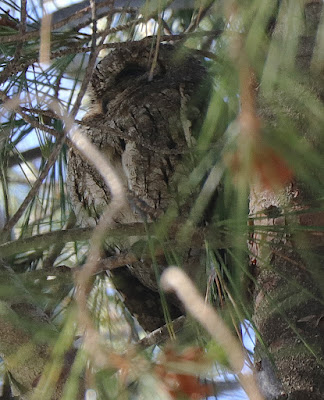As I drove slowly along Head Dyke Lane I heard a singing Chiffchaff and then saw a Kestrel watching over a field from an overhead line. At Gulf Lane the sitting Oystercatcher raised her head above the crop to see what the stopped vehicle was up to. She sounded a warning but the rapidly growing crop has already outpaced any tiny youngsters and I couldn’t see them. A pair of Skylarks circled and then dropped into the same area of the field and I made a mental note of the spot for another day.
All I saw from the Braides Farm gateway was a single Roe Deer, 400 yards from me but just a few yards from the sea wall with not a tree in sight; a strange beginning to my journey of Cockerham to Conder Green.
Roe Deer
There are still 3 pair of Avocets at Conder Pool and one pair have two youngsters that scurried along the water’s edge at their parents’ behest.
Avocets
Meanwhile the Oystercatchers with the roadside nest still play chicken with each car that passes by. It’s a weird routine they have; I watched them do the same thing over and over. The female stays on the nest for passing vehicles but if one slows or stops she walks off the nest, crosses the road to the edge of the creek, calls, and then waits until the male joins her. There’s a crow continually trying to rob the nest so one of the Oystercatchers is tasked with chasing off the villain. When all returns to normal, cars and crows, the female crosses the road again and sits back on the nest. If the “oyks” pull this one off they deserve a medal for perseverance.
A second pair of Oystercatchers that nested to the left of the screen now has two tiny youngsters, with at a guess still three to five other pairs yet to hatch their young.
Oystercatcher
Oystercatcher chick
Black-tailed Godwit numbered 120+ again feeding in the creek or the very far side of the pool. It’s late in May for so many lingering godwits when by rights they should be well north of here, especially since a good number are in adult-like plumage. Of course each day could see different birds passing through but who’s to know for sure? They are a colourful and welcome addition to the usual year round waders and I imagine a few non-breeders may actually spend the summer here.
Black-tailed Godwits
On the pool and close by – 1 Little Grebe, 6 Tufted Duck, 8 Shelduck, 10 Redshank, 2 Little Egret, 1 Grey Heron, 4 Whitethroat, 3 Reed Bunting, 2 Sedge Warbler, 1 Chiffchaff and 1 Reed Warbler.
Shelduck - male
Shelduck - female
There was another Reed Warbler on the Jeremy Lane circuit where the roadside ditches are in great shape with their mix of bramble, nettle, scattered hawthorn bushes and fine stands of phragmites reed.
On the leisurely circuit up to Cockersands and back I counted 10+ singing Sedge Warber, 8 Whitethroat, 8+ Skylark, 4 Reed Bunting and 1 Blackcap as i stopped here and there to take a closer look.
Sedge Warbler
Sedge Warbler
In the fields nearest to Cockersands where Lapwings and Skylarks were ploughed out by spring farming I noted at least three Lapwings sat in new nests. After the recent drought the earthis now almost bare and very dry. Let’s hope the Lapwings have better luck this time.
Lapwing
For weeks I’ve tried to get half decent pictures of a Brown Hare. Today the roadside growth partly hid the car as it slowly edged along the road allowing me to stop and turn off the engine. When soon another, taller vehicle came along the hare dashed off across the field into the distance.
Brown Hare
Brown Hare
Those long and powerful hind legs allow a Brown Hare to run at up to 35mph - pretty useful if you don’t fancy being “jugged” or roasted. On the other hand we all know the story of The Tortoise and the Hare, the best-known of Aesop's Fables where the hare loses a race through being over confident of its speed.
Maybe there’s a lesson for some birders? Slow down, you will both see and learn more by travelling at a nice steady pace, stopping and starting where necessary, instead of dashing around like a headless chicken and seeing bugger all.
Linking today to World Bird Wednesday and Anni's birding.
Linking today to World Bird Wednesday and Anni's birding.













































































































